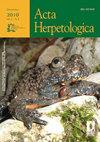Re-description of external morphology and factors affecting body and tail shape of the stone frog tadpoles
IF 0.9
4区 生物学
Q4 ZOOLOGY
引用次数: 0
Abstract
Ecological studies testing the preponderance of environmental filters on ontogeny to explain the variation in tadpole morphology are scarce for Neotropical anurans. We used tadpoles of the stone frog Limnomedusa macroglossa (Alsodidae): (1) to assess the variation in body and tail shape; (2) to examine the effect of streamlet depth and allometry on tadpole shape, and (3) to re-describe and compare the tadpole external morphology with closely related species. We obtained the body shape and size from 150 tadpoles. The re-description was based on 57 qualitative and 24 quantitative characters, from 19 tadpoles between stages 30 and 37 and 31 to 37, respectively. Allometry was the major factor influencing the lateral view of body shape: smaller tadpoles had round bodies and eyes and nostrils positioned more laterally in comparison with larger ones. Thus, the power of ontogenetic variations reported here makes the tadpole developmental “climax” period a questionable concept that deserves additional attention. The depth gradient of streamlets also affected the shape: in shallower environments, the tadpoles presented a decrease in height of the body, fins and tail muscles, and an increase in body width. These results may indicate adaptations allowing better swimming performance in lotic environments with intense water flow. The external morphological characterization of L. macroglossa presented here differed from that previously reported, mainly due to coloration, body shape, nostril, anal tube, tail, shape and position of nostrils and snout. Additionally, we presented unknown traits for this species, making comparisons with closely related species within the Alsodidae family.重新描述石蛙蝌蚪体尾外形的外部形态及影响因素
在新热带无尾目动物中,测试环境过滤器对个体发生的优势以解释蝌蚪形态变化的生态学研究很少。本研究以大舌石蛙(Limnomedusa macroglossa)蝌蚪为研究对象:(1)研究体尾形态的变化;(2)研究溪流深度和异速生长对蝌蚪外形的影响;(3)重新描述蝌蚪的外部形态,并与近缘种进行比较。我们获得了150只蝌蚪的体型和大小。对19只蝌蚪在30 ~ 37期和31 ~ 37期分别进行了57个定性性状和24个定量性状的重新描述。异速生长是影响身体侧面观的主要因素:小蝌蚪的身体是圆的,与大蝌蚪相比,眼睛和鼻孔的位置更偏向侧面。因此,这里报道的个体发生变异的力量使得蝌蚪发育的“高潮”期成为一个值得进一步关注的有问题的概念。溪流的深度梯度也影响了蝌蚪的形状:在较浅的环境中,蝌蚪的身体、鳍和尾部肌肉的高度下降,身体宽度增加。这些结果可能表明适应使得在水流剧烈的潮湿环境中有更好的游泳表现。本文报道的大舌舌鼠的外部形态特征与以往报道的不同,主要是由于颜色、体型、鼻孔、肛管、尾巴、鼻孔和口鼻的形状和位置。此外,我们提出了该物种的未知性状,并将其与近缘物种进行了比较。
本文章由计算机程序翻译,如有差异,请以英文原文为准。
求助全文
约1分钟内获得全文
求助全文
来源期刊

Acta Herpetologica
ZOOLOGY-
CiteScore
1.20
自引率
12.50%
发文量
10
审稿时长
6 months
期刊介绍:
Acta Herpetologica, a journal open to academics all over the world, offers itself as a new site for the presentation and discussion of the most recent results in the field of research on Amphibians and Reptiles, both living and extinct. The official journal of the Societas Herpetologica Italica (S.H.I.), Acta Herpetologica publishes original works – extended articles, short notes and book reviews – mostly in English, dealing with the biology and diversity of Amphibians and Reptiles.
 求助内容:
求助内容: 应助结果提醒方式:
应助结果提醒方式:


